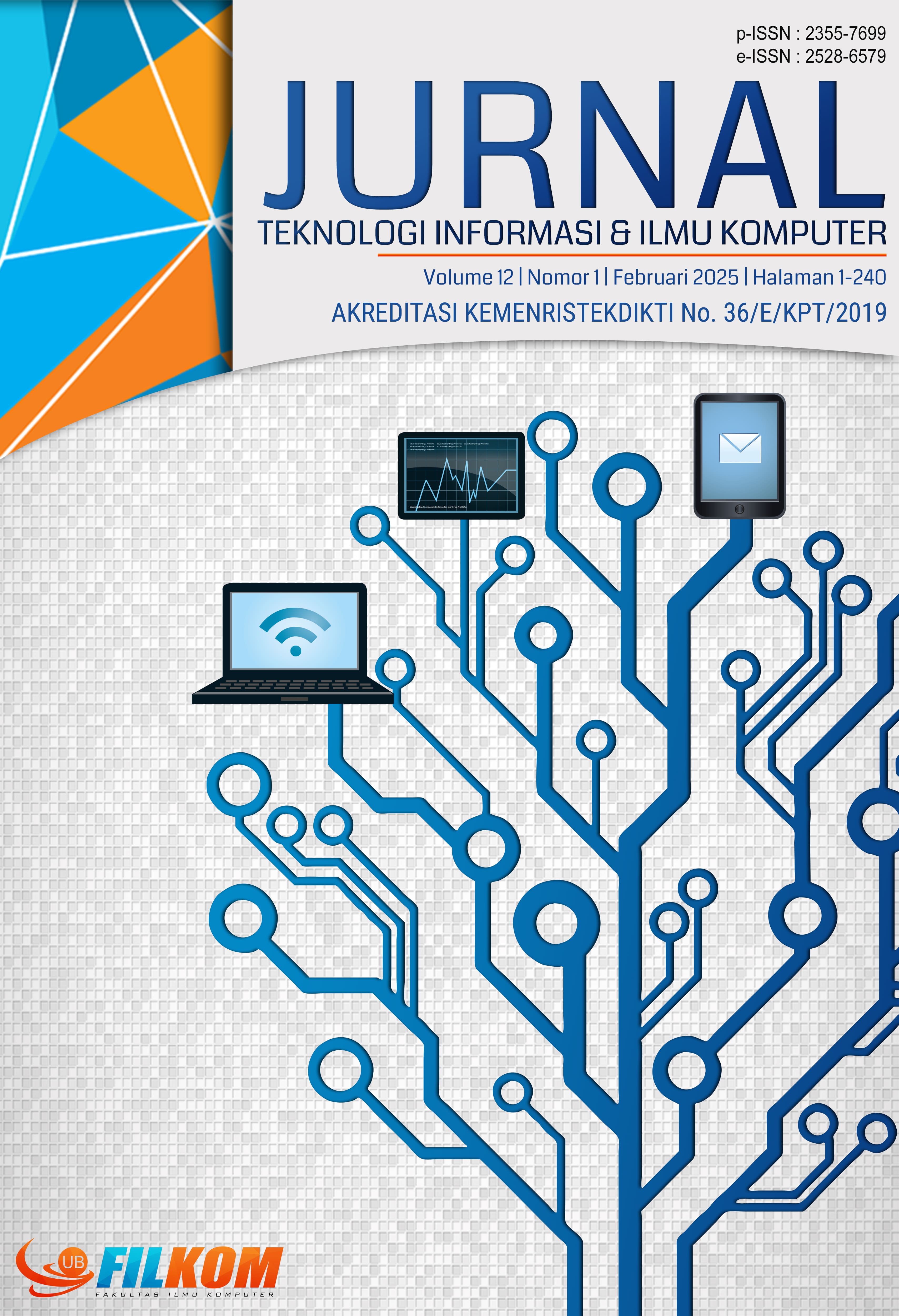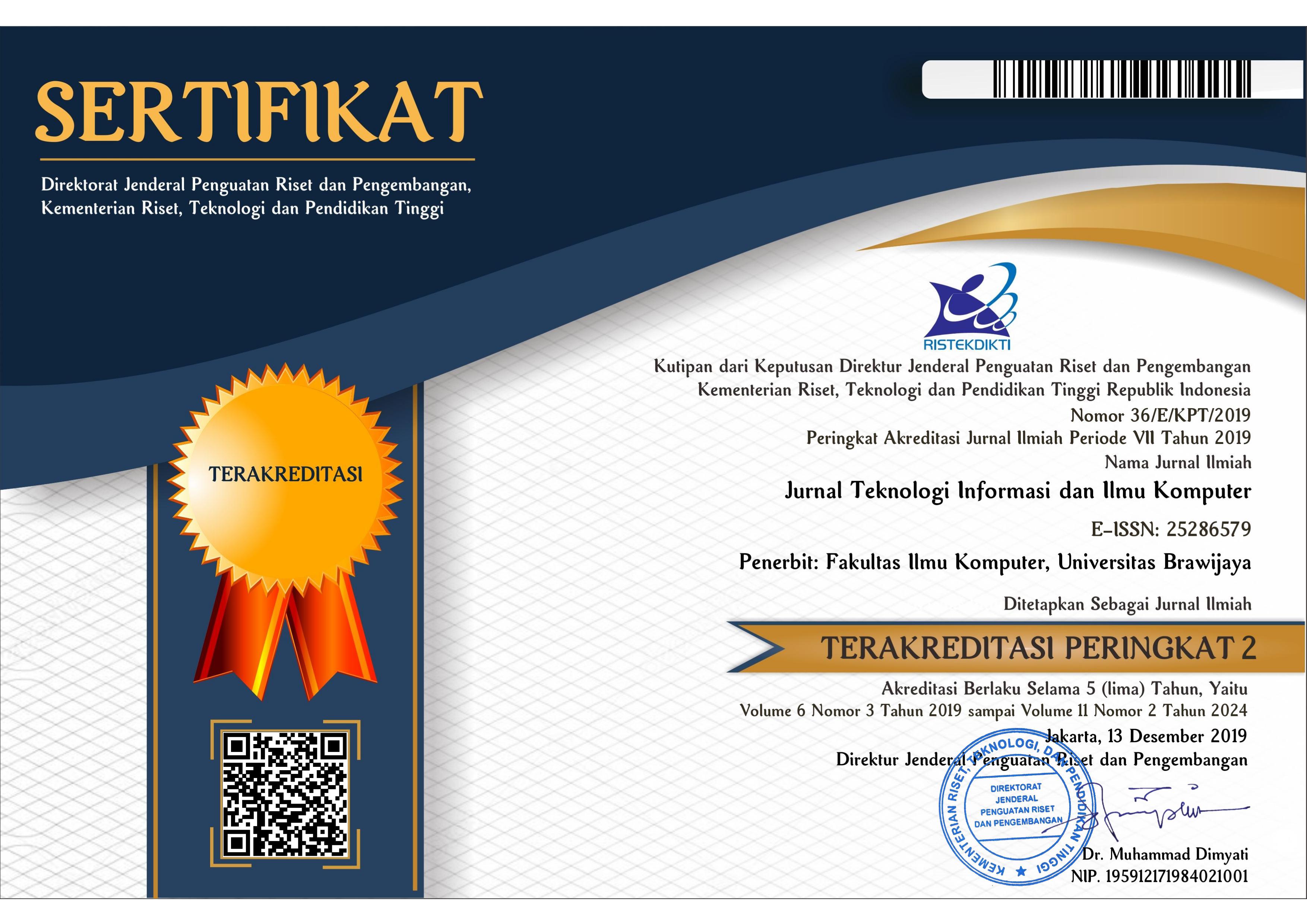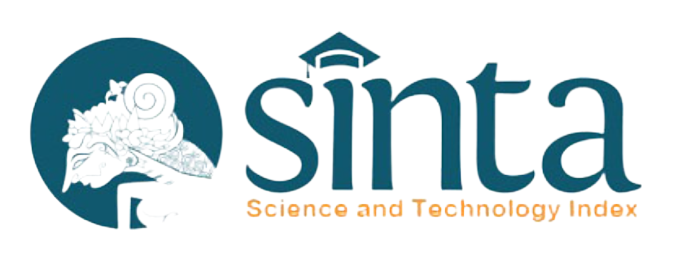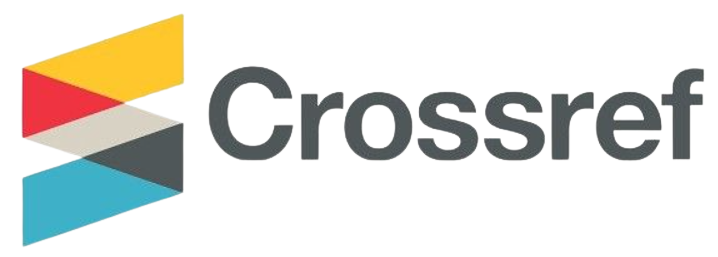Klasifikasi Katarak Berdasarkan Optic Disc Citra Fundus Smartphone: Perbandingan Ekstraksi Ciri Tekstur Dan Metode Neural Network
DOI:
https://doi.org/10.25126/jtiik.2025129254Kata Kunci:
cataract, smartphone fundus camera, backpropagation neural network (BPNN), probabilistic neural network (PNN), radial basis function neural network (RBFNN), optic discAbstrak
biaya tinggi pemeriksaan sering kali menjadi hambatan, terutama di Indonesia. Kamera fundus konvensional, meskipun efektif, memiliki harga yang mahal dan kurang portabel, membatasi aksesibilitas di daerah terpencil. Penelitian ini bertujuan untuk mengembangkan sistem klasifikasi katarak otomatis menggunakan kamera fundus berbasis smartphone, yang menawarkan solusi lebih ekonomis dan portabel dibandingkan perangkat konvensional. Penelitian ini mengevaluasi kinerja tiga algoritma jaringan syaraf tiruan yaitu, Backpropagation Neural Network (BPNN), Probabilistic Neural Network (PNN), dan Radial Basis Function Neural Network (RBFNN), dalam klasifikasi katarak. Metode penelitian meliputi pra-pengolahan citra, segmentasi optic disc, ekstraksi ciri tekstur menggunakan Gray-Level Co-occurrence Matrix (GLCM) dan Filter Gabor, serta klasifikasi tingkat keparahan katarak ke dalam empat kategori, yaitu retina normal, katarak ringan (mild), katarak sedang (medium), dan katarak berat (severe). Hasil pelatihan menunjukkan rerata nilai akurasi sistem sebesar 96,35%, dengan kinerja terbaik pada ekstraksi ciri GLCM menggunakan PNN (100%) dan Filter Gabor menggunakan PNN (96,88%). Sensitivitas tertinggi dalam pelatihan dicapai oleh metode GLCM dan PNN (100%) untuk kategori katarak normal dan berat. Pada pengujian, sistem mencapai nilai rerata akurasi sebesar 77,98%, dengan hasil terbaik pada ekstraksi ciri GLCM menggunakan PNN (89,29%). Sensitivitas tertinggi pada pengujian diperoleh dengan metode GLCM dan PNN (89,29%) untuk katarak ringan dan berat, sementara spesifisitas tertinggi dicapai oleh GLCM dan BPNN (95,24%) untuk katarak normal. Temuan ini menunjukkan bahwa sistem berbasis smartphone ini tidak hanya meningkatkan aksesibilitas diagnosis katarak di daerah terpencil tetapi juga memberikan akurasi yang kompetitif dengan solusi konvensional.
Absctract
Eye health, particularly cataract diagnosis, is a crucial aspect of individual well-being. However, the high cost of examinations often poses a barrier, especially in Indonesia. Conventional fundus cameras, while effective, are expensive and less portable, limiting accessibility in remote areas. This research aims to develop an automatic cataract classification system using smartphone-based fundus cameras, offering a more cost-effective and portable solution compared to conventional devices. The study evaluates the performance of three neural network algorithms: Backpropagation Neural Network (BPNN), Probabilistic Neural Network (PNN), and Radial Basis Function Neural Network (RBFNN) for cataract classification. The research methodology includes image preprocessing, optic disc segmentation, texture feature extraction using Gray-Level Co-occurrence Matrix (GLCM) and Gabor Filter, and classification of cataract severity into four categories: normal retina, mild cataract, medium cataract, and severe cataract. Training results show an average system accuracy of 96.35%, with the best performance on GLCM feature extraction using PNN (100%) and Gabor Filter using PNN (96.88%). The highest sensitivity in training was achieved by GLCM and PNN (100%) for normal and severe cataract categories. During testing, the system achieved an average accuracy of 77.98%, with the best results for GLCM feature extraction using PNN (89.29%). The highest sensitivity in testing was obtained with GLCM and PNN (89.29%) for mild and severe cataracts, while the highest specificity was achieved by GLCM and BPNN (95.24%) for normal cataracts. These findings indicate that the smartphone-based system not only enhances cataract diagnosis accessibility in remote areas but also provides competitive accuracy compared to conventional solutions.
Downloads
Referensi
AGARWAL, V., GUPTA, V., VASHISHT, V.M., SHARMA, K. AND SHARMA, N., 2019. Mobile Application Based Cataract Detection System. In: Proceedings of the International Conference on Trends in Electronics and Informatics, ICOEI 2019. Tirunelveli: IEEE. pp.780–787.
https://doi.org/10.1109/ICOEI.2019.8862774.
AHN, S.J. AND KIM, Y.H., 2024. Clinical Applications and Future Directions of Smartphone Fundus Imaging. Diagnostics, 14(13), pp.1–16.
https://doi.org/10.3390/diagnostics14131395.
ASRIL, B.W., MAISON, M. AND YUDERTHA, A., 2019. Analisis Performa Algoritma Segmentasi Pembuluh Darah pada Citra Fundus Retina. Jurnal Edukasi dan Penelitian Informatika (JEPIN), 5(3), p.272. https://doi.org/10.26418/jp.v5i3.34416.
ASSI, L., CHAMSEDDINE, F., IBRAHIM, P., SABBAGH, H., ROSMAN, L., CONGDON, N., EVANS, J., RAMKE, J., KUPER, H., BURTON, M.J., EHRLICH, J.R. AND SWENOR, B.K., 2021. A Global Assessment of Eye Health and Quality of Life A Systematic Review of Systematic Reviews. JAMA Ophthalmology, [online] 139(5), pp.526–541. https://doi.org/10.1001/jamaophthalmol.2021.0146.
CHALAM, K. V., CHAMCHIKH, J. AND GASPARIAN, S., 2022. Optics and Utility of Low-Cost Smartphone-Based Portable Digital Fundus Camera System for Screening of Retinal Diseases. Diagnostics, 12(6), p.1499. https://doi.org/10.3390/diagnostics12061499.
DAYA, B., ASMARA, Y., WULANINGRUM, R. AND HELILINTAR, R., 2023. Implementasi Region of Interest (ROI) Untuk Segmentasi Citra Tanda Tangan. In: Prosiding SEMNAS INOTEK (Seminar Nasional Inovasi Teknologi). Kediri: Universitas Nusantara PGRI Kediri. pp.2549–7952. https://doi.org/https://doi.org/10.29407/inotek.v7i3.3565.
DIANTARAKITA. AGUS WAHYU WIDODO. MUHAMMAD ARIF RAHMAN, 2019. Ekstraksi Ciri pada Klasifikasi Tipe Kulit Wajah Menggunakan Metode Local Binary Pattern. Jurnal Pengembangan Teknologi Informasi dan Ilmu Komputer, 3(8), pp.7938–7945.
ELVENY, M., ANJULINA, T., SIREGAR, B. AND SYAH, R., 2020. Identification of Diabetic Retinopathy with Retinal Fundus Imagery Using Probabilistic Neural Network. Journal of Physics: Conference Series, 1641(1). https://doi.org/10.1088/1742-6596/1641/1/012055.
FIRDAUS, D.H., IMRAN, B., BAKTI, L.D. AND SURYADI, E., 2022. Klasifikasi Penyakit Katarak Pada Mata Menggunakan Metode Convolutional Neural Network (CNN) Berbasis Web. Jurnal Kecerdasan Buatan dan Teknologi Informasi (JKBTI), 1(3), pp.18–26.
https://doi.org/https://doi.org/10.69916/jkbti.v1i3.6.
GAO, Y., YU, X., WU, C., ZHOU, W., WANG, X. AND CHU, H., 2019. Accurate and efficient segmentation of optic disc and optic cup in retinal images integrating multi-view information. IEEE Access, 7, pp.148183–148197. https://doi.org/10.1109/ACCESS.2019.2946374.
JUNIATI, D. AND SUWANDA, A.E., 2022. Klasifikasi Penyakit Mata Berdasarkan Citra Fundus Retina Menggunakan Dimensi Fraktal Box Counting Dan Fuzzy K-Means. Proximal: Jurnal Penelitian Matematika dan Pendidikan Matematika, 5(1), pp.10–18. https://doi.org/10.30605/proximal.v5i1.1623.
KAMBLE, V. V. AND KOKATE, R.D., 2020. Automated diabetic retinopathy detection using radial basis function. Procedia Computer Science, [online] 167(2019), pp.799–808. https://doi.org/10.1016/j.procs.2020.03.429.
MUNARTO, R., PERMATA, E. AND T, I.G.A., 2016. Klasifikasi Glaucoma Menggunakan Cup-To-Disc Ratio Dan Neural Network. In: Simposium Nasional Ke-15 RAPI 2016. Surakarta: Universitas Muhammadiyah Surakarta. pp.370–378.
MUNARTO, R. AND YUDONO, M.A.S., 2019. Klasifikasi Katarak Objek Optic Disc Citra Fundus Retina Menggunakan Support Veactor Machine. Jurnal Ilmiah Setrum, [online] 8(1), pp.84–95. https://doi.org/http://dx.doi.org/10.36055/setrum.v8i1.5793.
MUNARTO, R., YUDONO, M.A.S. AND PERMATA, E., 2020. Automatic Cataract Classification System Using Neural Network Algorithm Backpropagation. In: 2020 2nd International Conference on Industrial Electrical and Electronics (ICIEE). [online] Lombok: IEEE. pp.101–106.
https://doi.org/10.1109/ICIEE49813.2020.9277441.
RANI, K.C. AND PRASANTH, Y., 2017. A Decision System for Predicting Diabetes using Neural Networks. IAES International Journal of Artificial Intelligence (IJ-AI), 6(2), pp.56–65. https://doi.org/10.11591/ijai.v6.i2.pp56-65.
ROHAYA, S. AND HUSNA, C., 2024. Papil Edema. Detector: Jurnal Inovasi Riset Ilmu Kesehatan, 2(1), pp.235–242. https://doi.org/https://doi.org/10.55606/detector.v2i1.3347.
ROHMAH, S., 2022. Prevalence and Analysis of Risk Factors for Cataracts in Jember Regency, Indonesia. Sriwijaya Journal Of Opthalmology, [online] 5(1), pp.178–189. https://doi.org/https://doi.org/10.37275/sjo.v7i1.117.
SKORIN, L. AND NORBERG, S., 2019. The aging crystalline lens: A review of cataracts. ScienceOpen, 59(1), pp.0–1. https://doi.org/10.14293/S2199-1006.1.SOR-.PP5CQH9.v1.
SPECHT, D.F., 1990. Probabilistic Neural Networks. Neural Networks, 3, pp.109–118. https://doi.org/10.1007/s11069-015-1595-z.
SWASTIKA, W., 2020. Studi Awal Deteksi Covid-19 Menggunakan Citra Ct Berbasis Deep Preliminary Study of Covid-19 Detection Using Ct Image Based on. Jurnal Teknologi Informasi dan Ilmu Komputer, [online] 7(3), pp.629–634. https://doi.org/http://dx.doi.org/10.25126/jtiik.2020733399.
T, V., M, S., KUMARAVEL, A. AND B, K., 2020. Gabor filter and machine learning based diabetic retinopathy analysis and detection. Microprocessors and Microsystems, [online] p.103353. https://doi.org/10.1016/j.micpro.2020.103353.
WINTERGERST, M.W.M., JANSEN, L.G., HOLZ, F.G. AND FINGER, R.P., 2020. Smartphone-based fundus imaging - Where are we now? Asia-Pacific Journal of Ophthalmology, 9(4), pp.308–314. https://doi.org/10.1097/APO.0000000000000303.
YUDONO, M.A.S., HAMIDI, E.A.Z., KUSPRANOTO, A.H. AND SIDIK, A.D.W.M., 2022. Jaringan Syaraf Tiruan Perambatan Balik Untuk Klasifikasi Covid-19 Berbasis Tekstur Menggunakan Orde Pertama Berdasarkan Citra Chest X-Ray. Jurnal Teknologi Informasi dan Ilmu Komputer (JTIIK), 9(4), pp.799–808. https://doi.org/10.25126/jtiik.202295663.
YUDONO, M.A.S., ISNANTO, R.R. AND TRIWIYATNO, A., 2021. Comparison of Cataract Classification System Based on Retinal Blood Vessels Objects and Retinal Optic Disc Using Backpropagation Neural Network. International Journal of Innovations in Engineering and Technology (IJIET), 18(2), pp.1–8. https://doi.org/10.13140/RG.2.2.16638.46408.
Unduhan
Diterbitkan
Terbitan
Bagian
Lisensi
Hak Cipta (c) 2025 Jurnal Teknologi Informasi dan Ilmu Komputer

Artikel ini berlisensiCreative Commons Attribution-ShareAlike 4.0 International License.

Artikel ini berlisensi Creative Common Attribution-ShareAlike 4.0 International (CC BY-SA 4.0)
Penulis yang menerbitkan di jurnal ini menyetujui ketentuan berikut:
- Penulis menyimpan hak cipta dan memberikan jurnal hak penerbitan pertama naskah secara simultan dengan lisensi di bawah Creative Common Attribution-ShareAlike 4.0 International (CC BY-SA 4.0) yang mengizinkan orang lain untuk berbagi pekerjaan dengan sebuah pernyataan kepenulisan pekerjaan dan penerbitan awal di jurnal ini.
- Penulis bisa memasukkan ke dalam penyusunan kontraktual tambahan terpisah untuk distribusi non ekslusif versi kaya terbitan jurnal (contoh: mempostingnya ke repositori institusional atau menerbitkannya dalam sebuah buku), dengan pengakuan penerbitan awalnya di jurnal ini.
- Penulis diizinkan dan didorong untuk mem-posting karya mereka online (contoh: di repositori institusional atau di website mereka) sebelum dan selama proses penyerahan, karena dapat mengarahkan ke pertukaran produktif, seperti halnya sitiran yang lebih awal dan lebih hebat dari karya yang diterbitkan. (Lihat Efek Akses Terbuka).














